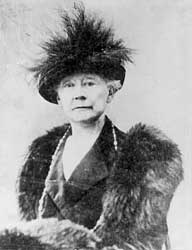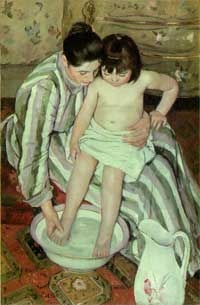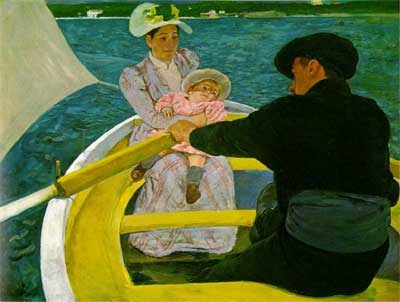 |
Have you ever wondered what qualifies people to be a hero? Probably not, because you say to yourself; they have to be strong, and brave, and important. But do they? Is the eight-year-old little girl who picks up the bag of groceries when her mom drops them and can’t pick them up a hero? Is the sweet regular guy who helps the little old lady cross the street a hero? I say, yes. A hero is a person who is trying to help, or who stands up for what he/she believes in no matter what! Well, I could talk all day about regular people who helped out and are now heroes, but my assignment is to talk about a hero, or should I say heroine, I’ve discovered; her name is Mary Cassatt. What’s that? You’ve never heard of Mary Cassatt? She’s the woman who changed people’s view of artists. Is she a hero? I say, absolutely!
 |
Mary Cassatt was born in beautiful Allegheny, Pennsylvania, on May 22, 1844. She had a mother, a father, and five loving brothers and sisters. When Cassatt was seven, her family moved to Paris, France. Her parents wanted their children to experience the artwork. When Cassatt saw the works of art, she was more amazed than any of her siblings. Sometime after, they moved back to America, but the artwork had made an everlasting impression on Cassatt.
It was in America when Mary Cassatt decided she was going to be an artist. Now in the 1880s, women, especially American women, were not thought to be artists so Cassatt had to do some begging to get Mr. Cassatt to send her to art school. He finally sent her to the Pennsylvania Academy for the Fine Arts for four years. When she was in school, some of her peers did not want her there; they did not accept her as a colleague. After school ended, she had a hard time getting anyone to teach her more, so she went to Paris, France, and taught herself by copying works of art in the museums.
"I would rather see you dead!” That’s what Mr. Cassatt said when he was informed that his daughter wanted to go to an art school. Her father and society didn’t accept American women as true artists, no matter how good their artworks were. Another challenge came when she had to make the difficult decision between painting the way judges at a museum liked it, or going along with a group of artists who liked to paint their own impressions of things. These artists were called “Impressionists” because their works left people with a feeling. Their paintings weren’t meant to look like photographs. Some famous “Impressionists” were Monet, Edgar Degas and, of course, Mary Cassatt.
 |
Even though Cassatt loved pleasing everyone, that meant not painting, and she could not do that. She was also very determined when she had trouble getting into schools. When people said her artwork was not good, she was confident; she liked the way she painted, so she continued painting in that style. When her father said, "No," to art school, she persevered until she was sitting in that seat to become what she wanted to become.
One of Cassatt’s greatest accomplishments was a mural she was commissioned to do for the women’s building at the Chicago World’s Fair. In addition to filling the world with her beautiful paintings of children, mothers, love, and kindness, Cassatt made people realize that it didn’t matter whether a woman or a man painted it; good artwork is good artwork. For these reasons Mary Cassatt is a true hero!
Page created on 4/22/2015 7:42:24 PM
Last edited 1/4/2017 9:54:56 PM
